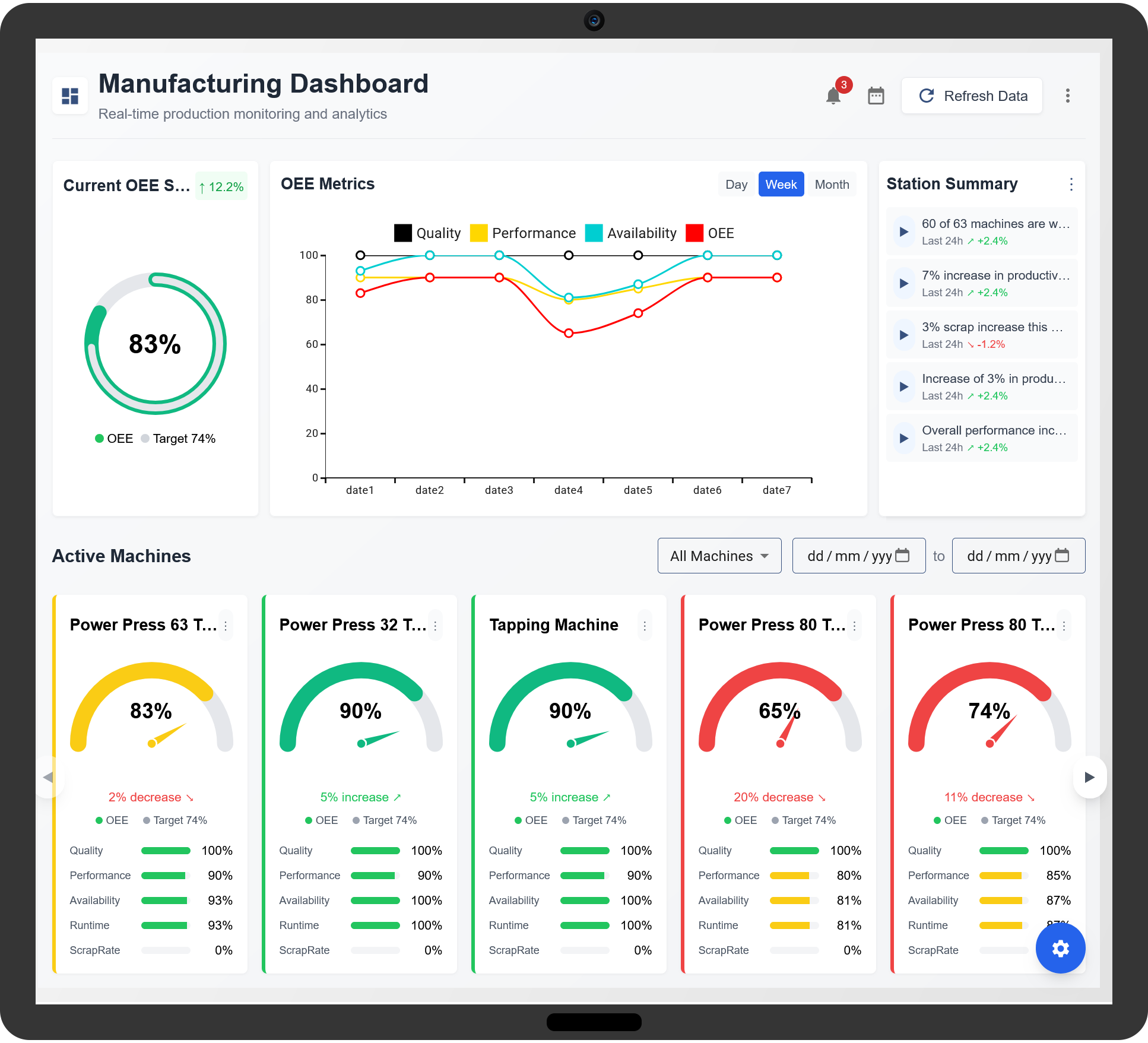In modern manufacturing, real-time monitoring of production efficiency is essential for maintaining high performance and reducing operational losses. A Real-Time OEE (Overall Equipment Effectiveness) Production Monitoring System enables manufacturers to track machine performance, reduce downtime, and optimize production processes with live data insights. By implementing a real-time OEE system, organizations can achieve higher productivity, better resource utilization, and improved decision-making.

1. Understanding Real-Time OEE Monitoring
OEE is a key metric used to measure manufacturing efficiency. It is calculated using three main components:
- Availability: Measures the percentage of actual operational time compared to planned production time.
- Performance: Evaluates the speed of operations compared to the maximum possible speed.
- Quality: Assesses the proportion of defect-free products compared to total production output.
A Real-Time OEE Production Monitoring System continuously tracks these parameters, providing live data to operators and managers, allowing immediate corrective actions.
2. Key Features of a Real-Time OEE System
Real-time OEE monitoring systems offer a wide range of features to optimize production efficiency:
- Live Data Collection: Captures real-time machine performance and production output.
- Automated Downtime Tracking: Identifies unplanned stoppages and categorizes downtime reasons.
- Visual Dashboards: Displays performance metrics through graphs, charts, and indicators.
- Instant Alerts and Notifications: Sends alerts when production deviates from expected efficiency.
- Performance Benchmarking: Compares efficiency across shifts, machines, and production lines.
- Defect Tracking: Monitors product quality by recording and analyzing defect rates.
3. Benefits of Implementing a Real-Time OEE System
Manufacturers gain significant advantages by deploying a real-time OEE system, including:
- Faster Issue Resolution: Immediate identification of bottlenecks and inefficiencies.
- Reduced Downtime: Quick detection and resolution of machine failures.
- Optimized Resource Utilization: Ensures effective use of labor, materials, and machinery.
- Improved Decision-Making: Provides accurate data for strategic improvements.
- Enhanced Productivity: Maximizes output by eliminating inefficiencies.
- Consistent Product Quality: Ensures high-quality manufacturing by monitoring defects in real time.
4. Steps to Implement a Real-Time OEE System
For successful integration, manufacturers should follow these steps:
- Define Monitoring Objectives: Identify the key performance indicators to track.
- Integrate with Production Equipment: Ensure compatibility with machines and data collection tools.
- Set Up Dashboards and Alerts: Configure real-time displays for better visibility.
- Train Employees: Educate staff on how to use the system for maximum benefit.
- Analyze Data and Optimize: Regularly review reports and implement continuous improvements.
5. Customizing Reports for Better Insights
A real-time OEE monitoring system allows the creation of tailored reports, such as:
- Shift Performance Reports: Evaluates efficiency across different shifts.
- Machine Utilization Reports: Identifies underperforming equipment.
- Defect Rate Reports: Tracks quality issues and trends.
- Production Bottleneck Reports: Highlights areas where workflow is slowed down.
6. Challenges in Real-Time OEE Monitoring
While real-time monitoring improves efficiency, challenges include:
- Data Accuracy: Ensuring sensors and collection systems provide reliable data.
- System Integration: Connecting OEE software with existing manufacturing systems.
- Operator Adoption: Encouraging workers to actively use real-time insights.
- Continuous System Maintenance: Keeping software updated for peak performance.
7. Future Trends in Real-Time OEE Monitoring
The future of real-time OEE monitoring includes advancements such as:
- AI-Driven Predictive Analytics: Using machine learning to anticipate failures and improve maintenance scheduling.
- Cloud-Based OEE Solutions: Enabling remote access and monitoring from any location.
- IoT-Enabled Devices: Enhancing real-time data collection with smart sensors.
Real-Time OEE Production Monitoring System
What is a Real-Time OEE Production Monitoring System?
A real-time OEE production monitoring system tracks and analyzes overall equipment effectiveness in real time, providing instant insights into production efficiency.
How does real-time OEE monitoring work?
It collects data from machines and sensors, processes it instantly, and displays key metrics such as availability, performance, and quality on dashboards.
What key metrics does a real-time OEE system track?
It tracks availability (machine uptime vs. downtime), performance (actual vs. optimal production speed), and quality (good units vs. defective units).
How does real-time monitoring improve production efficiency?
It helps identify inefficiencies, reduce waste, optimize machine utilization, and ensure faster corrective actions to enhance productivity.
Can a real-time OEE system integrate with existing production software?
Yes, real-time OEE systems can integrate with MES, ERP, and SCADA systems for seamless data exchange and comprehensive production insights.
What industries benefit most from real-time OEE monitoring?
Industries such as automotive, food and beverage, pharmaceuticals, electronics, and heavy machinery manufacturing benefit the most.
How does real-time OEE data help reduce downtime?
It provides instant alerts on performance deviations, allowing operators to take preventive measures and minimize unplanned stoppages.
What are the main features of a real-time OEE production monitoring system?
Features include live dashboards, automated reports, predictive maintenance alerts, downtime analysis, and historical trend tracking.
How does real-time OEE monitoring support lean manufacturing?
By providing immediate visibility into waste, inefficiencies, and bottlenecks, real-time OEE systems help maintain lean production processes.
Can real-time OEE data be accessed remotely?
Yes, modern OEE systems offer cloud-based access, allowing managers to monitor production performance from anywhere.
How does real-time OEE tracking help in predictive maintenance?
By analyzing trends in machine performance, the system predicts potential failures and schedules maintenance before issues arise.
What challenges can occur when implementing a real-time OEE system?
Challenges include data integration, employee training, network reliability, and aligning OEE goals with production objectives.
How does automation enhance real-time OEE monitoring?
Automation enables seamless data collection, reduces manual errors, and ensures accurate real-time reporting for better decision-making.
What role does IoT play in real-time OEE production monitoring?
IoT sensors collect machine data continuously, enabling real-time performance tracking, predictive maintenance, and process optimization.
How can manufacturers successfully implement a real-time OEE system?
Successful implementation requires proper system integration, employee training, continuous monitoring, and alignment with business objectives.